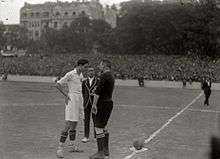René Petit
Renato Petit de Ory, better known by its French name, René Petit (October 8, 1899 – October 14, 1989[1]) was a Franco-Spanish engineer, known for being a footballer in his youth. He was one of the most popular players in Spanish football in the 1910s, 1920s and 1930s, playing for Real Madrid and Real Unión, and becoming a member of the French national team.
 | |||
| Personal information | |||
|---|---|---|---|
| Full name | Renato Petit de Ory | ||
| Date of birth | October 8, 1899 | ||
| Place of birth | Dax, Landes, France | ||
| Date of death | October 14, 1989 | ||
| Playing position(s) | Midfielder | ||
| Senior career* | |||
| Years | Team | Apps | (Gls) |
| 1916–17 | Madrid FC | ||
| 1917–18 | Stade Bordelais | ||
| 1920–32 | Real Unión | ||
| National team | |||
| 1920 | France | 2 | (0) |
| * Senior club appearances and goals counted for the domestic league only | |||
Biography
Renato or René Petit lived his life traveling between Spain and France.[2] The son of a French engineer who held the post of head of traffic at the Company of Railways in Northern Spain. His mother was Spanish, more specifically born in Madrid.
Born in Dax, France[2] – which may be considered as a coincidence, since his mother had traveled to that town for treatments at the thermal waters – his childhood was spent in the Basque Country, between the towns of Irun and Hondarribia, the former town being the terminus of the Spanish rail network, where his father worked. Petit lived in a wealthy family and had a thorough education of the French type. At 12, he moved to live in Madrid,[2] where he attended high school at the Colegio El Pilar.
Football career
Petit never considered himself a striker, but a player who provided passing and support. He could play center forward but most of his career he played as a midfielder. Many consider that Petit modernized Spanish football, by establishing passing and team play against the previously existing anarchy.[2]
Madrid FC
At the El Pilar college, Petit started out playing as a centre forward; from there he went to Real Madrid C.F.'s reserve team. At the age of 14, he debuted with the first team.[2]
Rene and his elder brother, Juan Petit, made themselves noticed during the 1914–15 season at Madrid. At that time, Rene was 15 years old. Petit became one of the stars of Real Madrid in the 1910s, being slim and powerful, he can be considered the first player of the modern era because of its ability to interpret the game.
With Petit in the first team, Madrid reached the final of the Spanish Cup on two occasions, 1916 and 1917, winning the title on the latter occasion. The final held in 1917 against Arenas de Getxo marked the consecration of the 17-year-old Petit; a personal René occasion, dribbling all who came out against the step, allowed Madrid to equalize, and finally win with a goal from Ricardo Alvarez in extra-time.
His older brother didn't play in the match, since shortly before the final he was drafted into the French army. He was severely injured in World War I and this put an end to his playing career prematurely.
Petit's career at Madrid is summarized in 29 games and 13 goals, a Spanish Cup, and two regional championships.
Real Union
Petit, rather than remain connected to Real Madrid, preferred to continue playing football for the team of his hometown, the Real Unión de Irún, which he joined in 1917. In 1918 he reached the Copa del Rey final again, but this time with Real Unión, contributing to the defeat of his former team, 2–0, and winning his second Cup title.[2] In 1924 he won another Copa del Rey defeating again the Real Madrid in the final.
References
- "René Petit: muere un mito". El Mundo Deportivo (in Spanish). October 19, 1989. Retrieved October 16, 2010.
- "The French Basque Country: a rugby heartland with world-class footballers". The Guardian. December 8, 2014. Retrieved June 11, 2017.